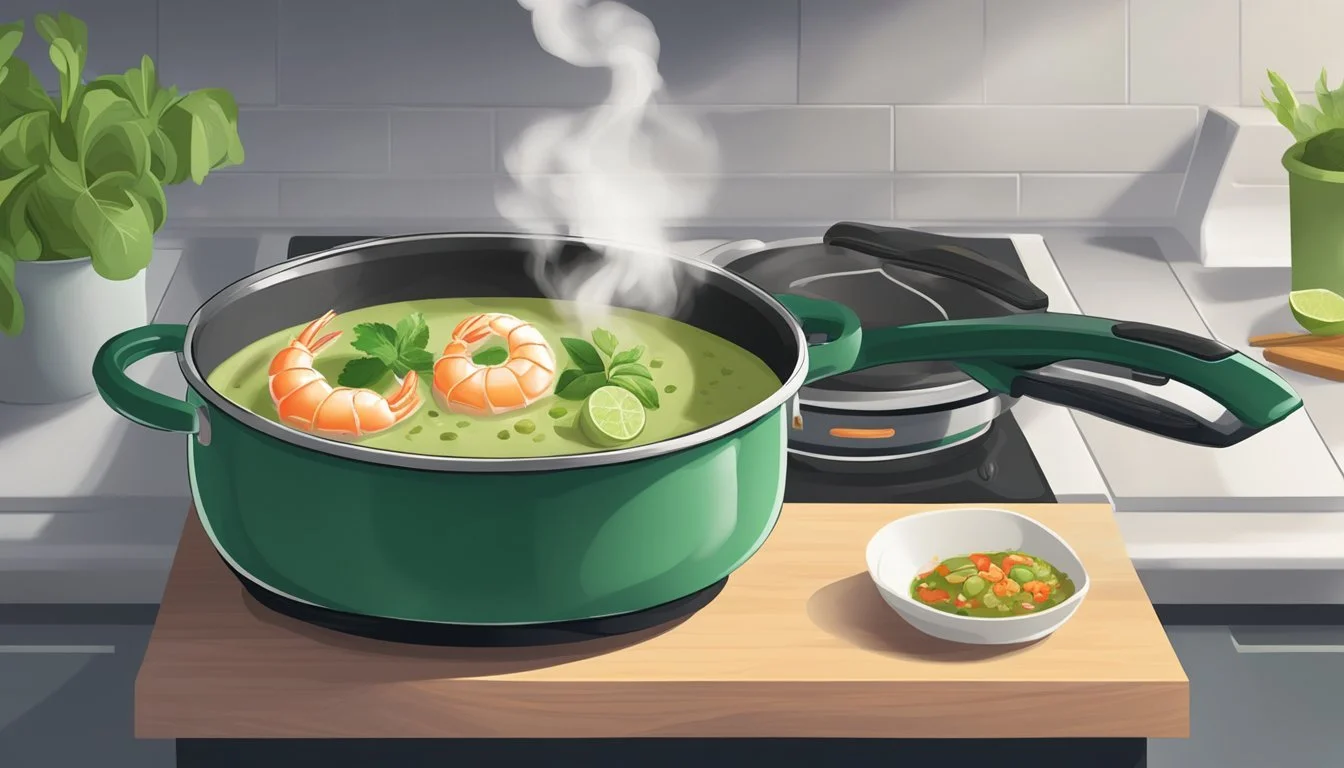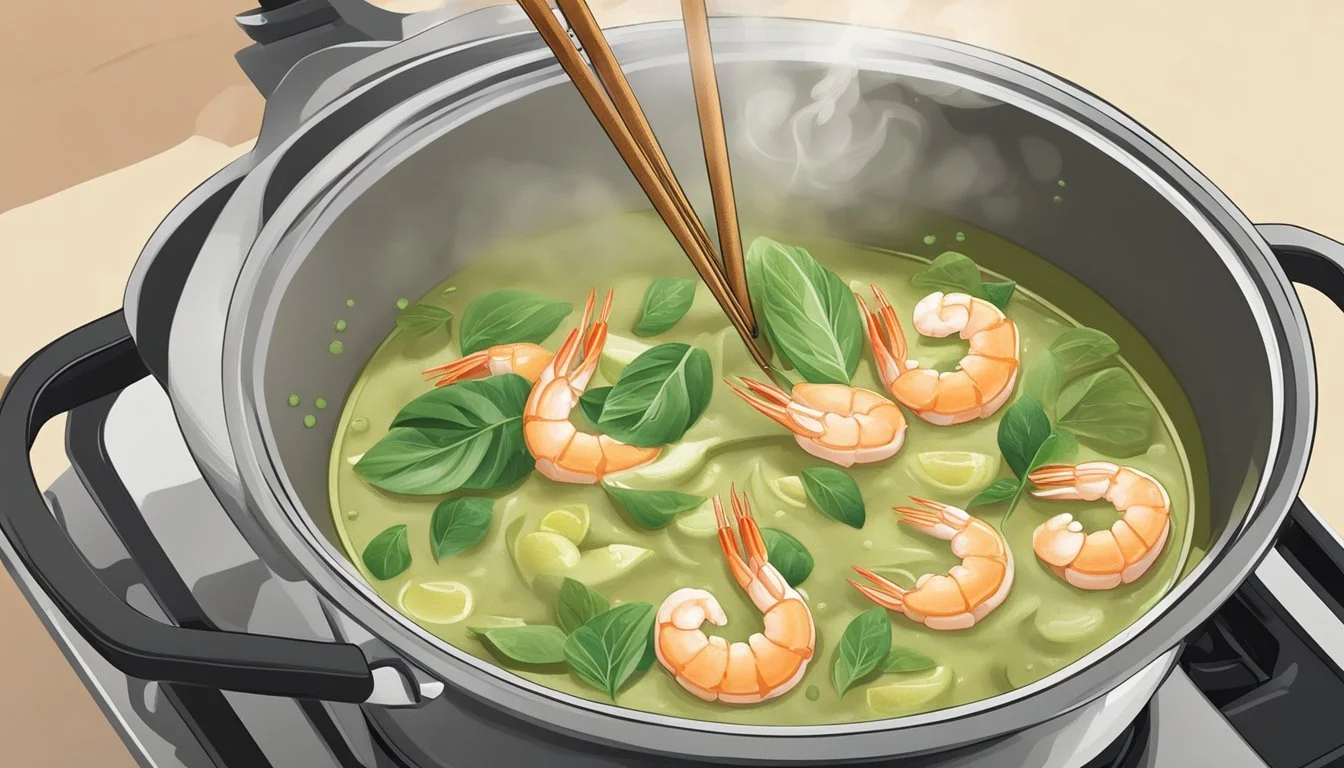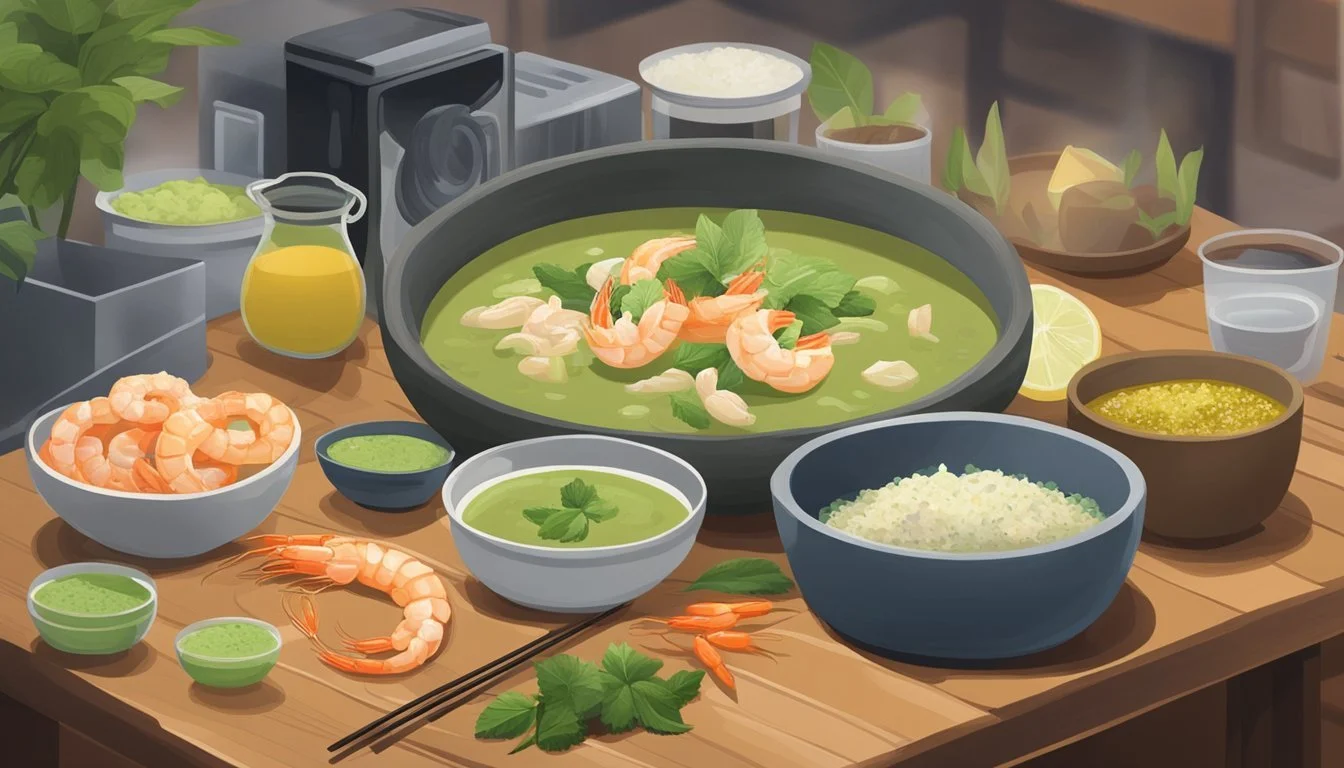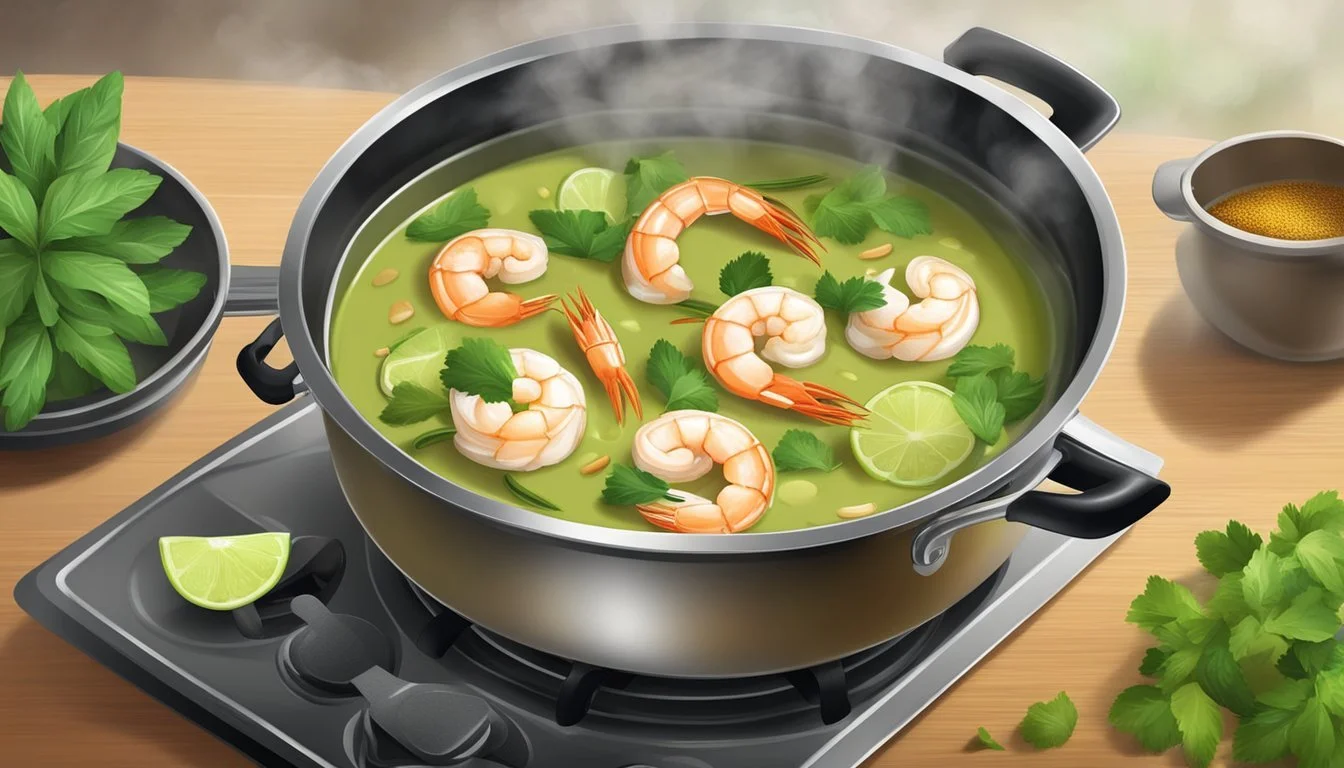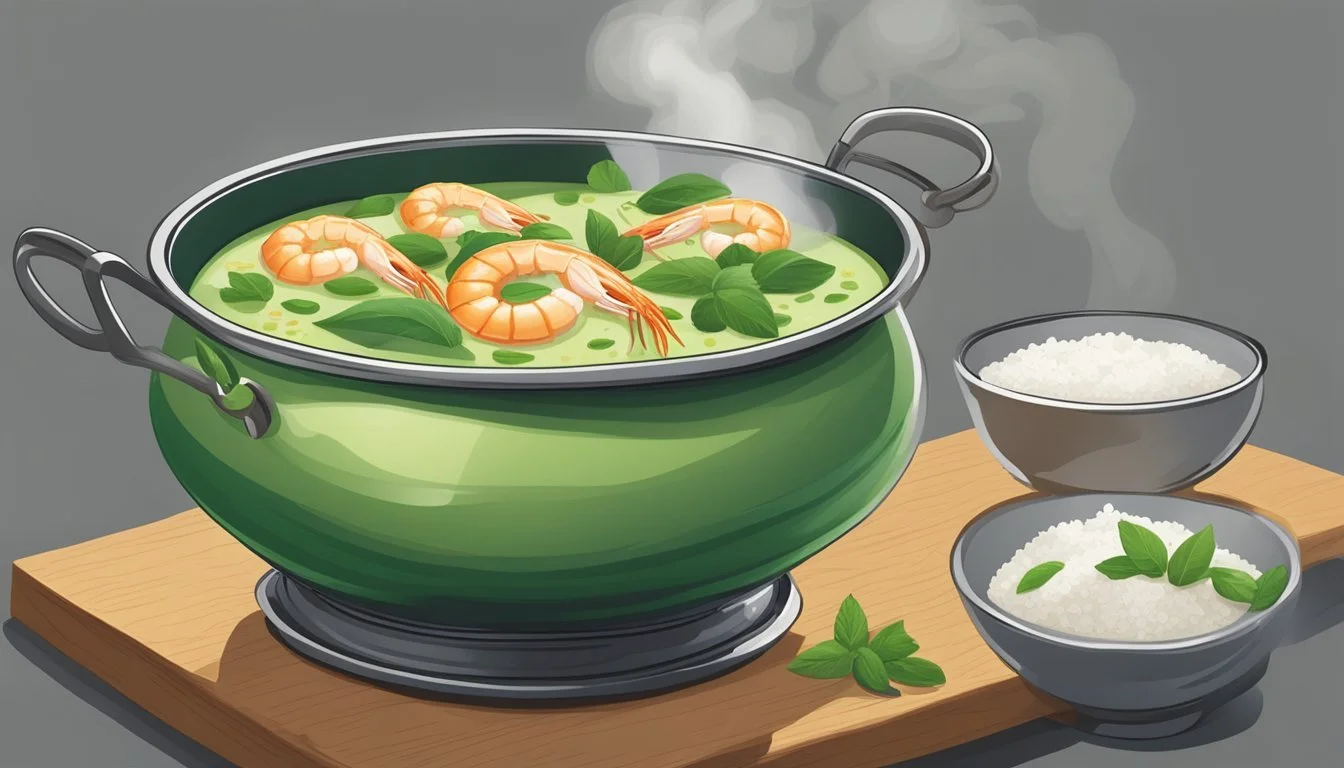Best Way to Reheat Green Curry with Shrimp
Ensuring Flavorful Warmth
Green curry with shrimp is a cherished dish known for its complex blend of aromatic spices and flavors. Preserving its freshness and depth of flavor during reheating is crucial to enjoy it as intended. Careful heating methods are necessary to ensure that the delicate shrimp do not become overcooked and the vibrant flavors of the curry remain intact. The best way involves a slow and gentle reheat, allowing the spices to bloom without compromising the texture of the shrimp.
The oven is often favored for reheating since it provides a consistent and even heat. To retain moisture and prevent the curry from drying out, it's recommended to add a bit of water or stock before covering the dish. Using a low temperature setting ensures that the curry warms through without reaching a boil, which could toughen the shrimp and cause the aromatic ingredients to lose their potency. Patience is key in the reheating process as frequent stirring and checking helps distribute heat evenly and gauge when the curry has been thoroughly warmed.
Understanding the Fundamentals of Reheating Green Curry
When reheating green curry with shrimp, maintaining the integrity of its aromatic flavors and delicate texture is crucial. The right reheating technique can make the difference between a vibrant, tantalizing dish and a disappointing one.
Importance of Temperature Control
Temperature plays a pivotal role in reheating green curry effectively. Heat must be applied gently and evenly to prevent the shrimp from becoming tough and the aromatic ingredients from losing their integrity.
Low to Medium Heat: Start with a low to medium setting when using a stovetop. This ensures the curry heats without causing the shrimp to overcook.
Oven Reheating: If using an oven, preheat it to a low temperature around 300°F (150°C) to avoid breaking the delicate curry sauce or drying out the shrimp.
Effects of Reheating on Flavor and Texture
The flavor and texture of green curry can be compromised if not reheated with care. The main objective is to preserve the curry's essence while bringing it to a suitable eating temperature.
Avoid High Heat: Intense heat can cause the spices to become bitter and the coconut milk to separate, deteriorating the curry’s creamy texture.
Stirring Regularly: Stir the curry frequently to ensure even heat distribution and to integrate the flavors throughout the dish. This prevents the bottom from scorching, which can impart an unwanted burnt flavor.
By embracing these fundamental techniques, one can reheat a leftover green curry with shrimp that remains flavorful and enjoyable, closely resembling its freshly-cooked state.
Preparation Steps Before Reheating
Before reheating green curry with shrimp to preserve its aromatic flavors, one should ensure that the curry is prepared in a manner that maintains its texture and taste. The choice of container and moisture addition are crucial steps in this preparatory process.
Choosing the Right Container
Selecting an appropriate container is vital for evenly reheating green curry with shrimp. The container must be oven-safe if using an oven to reheat. Glass or ceramic containers are typically suitable and should come with a tight-fitting lid, or one should have aluminum foil on hand to create an airtight cover. This helps to lock in the flavors and prevents the curry from drying out.
Adding Moisture to Prevent Dryness
To keep the green curry from losing its moisture during the reheating process, one may need to add a small amount of liquid. It is recommended to add:
A tablespoon or two of water or chicken/vegetable stock.
This should be gently mixed into the curry before reheating. If the curry is served with rice, ensure that the rice is moist as well; if it appears dry, lightly sprinkle water over it before reheating to avoid dryness.
Reheating Methods for Green Curry
When reheating green curry with shrimp, it is essential to maintain the delicate balance of flavors and avoid overcooking the shrimp. The following methods, if followed correctly, can preserve the integrity of your green curry.
Microwave Technique and Tips
For a quick reheat, use the microwave. Place the green curry in a microwave-safe dish and cover it with a microwave-safe lid or plastic wrap, allowing a corner to vent. Microwave the curry on medium power in 30-second intervals, stirring after each interval to distribute heat evenly. This prevents hot spots and ensures the shrimp does not become rubbery.
Stovetop Reheating Strategy
The stovetop method gives greater control over the heat. Place the green curry in a saucepan or skillet and warm it over low to medium heat. Stirring occasionally, allow the curry to reach a simmer but not a full boil. Simmering gently ensures the shrimp remains tender while reheating the sauce thoroughly.
Oven Reheating Process
For evenly distributed warmth, the oven is a viable option. Preheat it to 300°F (150°C). Transfer the curry to an oven-safe dish, and add a splash of water if needed to loosen the sauce. Cover the dish with foil and place it in the oven. Stir the curry halfway through the reheating time, which should take about 10-15 minutes. Checking the internal temperature ensures it's heated to a safe level without overcooking the shrimp.
Ensuring Safe Reheating Practices
Reheating green curry with shrimp not only involves restoring its warmth and flavors but also ensuring that the dish remains safe to consume. This is critical in preserving both the delicate taste of shrimp and the aromatic zest of green curry spices while preventing foodborne illnesses.
Internal Temperature and Food Safety
Achieving the correct internal temperature is essential for food safety. For seafood like shrimp in a green curry, it is recommended to reheat until the shrimp reaches an internal temperature of 145°F (63°C). Using a food thermometer can help ascertain that the curry has been heated adequately to eliminate potential foodborne pathogens.
Checking Temperature: Insert the thermometer into the thickest part of the shrimp.
Critical Point: Ensure that the entire dish, not just individual components, reaches this safe temperature.
Avoiding Overheating and Spoilage
When reheating, a gentle approach is important to avoid overheating. Overcooked shrimp can become tough, and high heat can cause the flavors of green curry to become muted or altered. Detailed attention should be given to heating the curry incrementally to prevent spoilage from exposure to excessive temperatures.
Guidelines for Oven Reheating:
Heat to just 145°F (63°C) and not beyond.
Cover the dish tightly to retain moisture.
Stir the curry occasionally for even heating.
Microwave Reheating Tips:
Use medium power to avoid rapid overheating.
Cover with a microwave-safe lid or vented plastic wrap.
Stir regularly, and check the temperature frequently.
Enhancing the Curry After Reheating
Once the green curry with shrimp is reheated to the perfect temperature, enhancing its flavors and aromas is the next step. Adjusting spices and adding fresh garnishes can elevate the dish from mere leftovers to a lively and aromatic meal.
Adjusting Spices and Seasonings
To balance the flavors, a chef may add a pinch of salt or a spoonful of sugar, depending on one's taste. For green curry that has lost a bit of its pungency, reinvigorating its spice profile is essential. A small amount of fresh green chili may enrich the heat, while a touch of cumin could restore earthiness.
Spices and Seasonings Adjustments:
Salt: A pinch to enhance flavor
Sugar: A spoonful to balance spices
Green chili: Minced, for added heat
Cumin: A pinch, to restore earthy tones
Garnishing and Adding Freshness
Garnishing is about more than aesthetics – it introduces complexity and zing. Sprinkling finely chopped cilantro over the curry adds a burst of herby freshness. A squeeze of lime provides a bright citrus note, while a dollop of coconut milk or a swirl of cream can both soften intense flavors and enrich the consistency of the curry.
Fresh Garnishes to Consider:
Cilantro: Finely chopped, for herbal brightness
Lime: Squeezed, for sharp citrus notes
Coconut Milk: A dollop for creamy consistency
Cream: Swirled in to soften and enrich
Incorporating fresh herbs and a splash of lemon juice not only revitalizes the flavor profile but also infuses the dish with a pleasant aroma. Adding these finishing touches ensures that the reheated green curry with shrimp remains an enticing and flavorful dish.
Storage Solutions for Leftover Curry
Proper storage is crucial for maintaining the flavor and safety of leftover curry. This section outlines the steps one should take to refrigerate or freeze green curry with shrimp to ensure it retains its aromatic flavors.
Best Practices for Refrigerating Curry
When storing green curry with shrimp in the fridge, one should always place the curry in airtight containers to prevent cross-contamination and odor absorption from other foods. The refrigerator temperature should be below 40°F (4°C) to inhibit bacterial growth. For best results, leftovers should be consumed within 1-2 days as seafood can spoil rapidly.
Step 1: Allow the curry to cool to room temperature for a maximum of two hours to prevent bacterial growth.
Step 2: Transfer the curry into airtight containers.
Step 3: Seal the containers tightly and label them with the date.
Freezer Storage Tips
Freezing green curry with shrimp is convenient and extends its shelf life. However, the texture of shrimp can change when frozen; it's best to add fresh shrimp during reheating instead. If one chooses to freeze the curry with shrimp, do so by following these guidelines:
Cooling: Cool the curry promptly after consumption.
Portioning: Divide into portion-sized containers. This way, one only reheats the amount needed, avoiding repeated freeze-thaw cycles.
Packaging: Place the curry into freezer-safe airtight containers or heavy-duty freezer bags.
Freezing: Freeze at 0°F (-18°C) immediately after packing.
Shelf Life: Properly stored, the curry can be kept in the freezer for up to two months for optimal taste, though it remains safe beyond that period.
Serving Suggestions Post-Reheating
After properly reheating green curry with shrimp, serving it in a way that enhances its flavor and presentation is crucial. This section outlines the perfect accompaniments to pair with the dish as well as tips for presenting it appealingly.
Recommended Accompaniments
Jasmine Rice: Fluffy jasmine rice is the ideal base for green curry with shrimp due to its fragrant aroma which complements the zestful flavors of the curry.
Naan Bread: A side of warm naan bread not only adds a different texture to the meal but also helps to sop up the savory curry sauce.
Plating and Presentation
The presentation of green curry with shrimp should be both inviting and functional. Serve the curry over a bed of steaming jasmine rice. For an aesthetic touch, consider garnishing with a sprig of cilantro or a slice of lime on the side. Always present naan bread on a separate plate to maintain its crispness.
Understanding Different Types of Curries
When exploring the world of curries, it is imperative to understand that each type has distinct characteristics stemming from its cultural origins, ingredients, and cooking methods. The section below focuses on Thai Green Curry and its place in the wider curry spectrum.
Characteristics of Thai Green Curry
Thai Green Curry, recognized for its vibrant hue and herbal flavor, is a staple in Thai cuisine. Central to its flavor profile is green curry paste, which typically consists of green chilies, shallots, garlic, lemongrass, kaffir lime leaves, and cilantro roots. These ingredients are ground together to release their aromatic qualities. Thai shrimp curry often incorporates this paste along with coconut milk, creating a creamy and rich seafood curry that is both spicy and sweet.
Key Ingredients: Green chilies, lemongrass, garlic, shallots, cilantro roots
Common Proteins: Shrimp, chicken, fish
Flavor Profile: Fragrant, slightly sweet, moderately spicy
Color: Green, from the chilies and fresh herbs
Differences in Curry Varieties
Curries around the world vary widely, and their differences are a reflection of cultural tastes and available ingredients.
Thai Curries often use fresh herbs, roots, and coconut milk, leading to a fresh, aromatic flavor often with a creamy texture. Aside from green curry, other popular types include red and yellow curries.
Indian Curry traditionally signifies a variety of dishes that use a complex blend of spices including turmeric, cumin, coriander, and chili powder.
Texture: Indian curries are commonly thick and have a more stew-like consistency.
Flavor: They can range from mild to extremely spicy, depending on the region and the dish.
Chicken Curry is a popular variety with numerous regional recipes across India.
Seafood Curries show great diversity, with Thai green curry including seafood like shrimp to offer a delicate balance of flavors suited to the ingredients' natural sweetness. However, seafood can also be found in Indian curries where it is often enveloped in a richly spiced sauce, contrasting Thai curries known for their brightness.
Key Ingredients in Green Curry
A traditional green curry is renowned for its complex flavors and fragrant spices. The right balance of ingredients is crucial in achieving its distinct taste.
Identifying Essential Curry Components
Green curry's backbone is constituted by its green curry paste, a blend of aromatic components including garlic, ginger, and chilies. The paste often contains a variety of other herbs and spices, tailoring the heat and depth to the dish. Coconut milk is another pivotal ingredient; full-fat coconut milk delivers a creamy texture and rich flavor that forms the base of the curry.
Role of Shrimp and Vegetables
Shrimp offers a delicate, seafood element to green curry, complementing the robust flavors of the curry paste. The freshness and quality of the shrimp are pivotal—they should not be overcooked to maintain their succulent texture.
Vegetables add not only a spectrum of colors but also textures and nutritional value to the dish. Commonly used vegetables in green curry include green beans and bell peppers. These are selected for their crunch and ability to absorb the curry's vibrant flavor.
In third person perspective, one should note that the dish’s authenticity and richness hinge on the harmony of these ingredients, including the judicious use of fish sauce for umami, and a hint of sugar to offset the spice and acidity.


